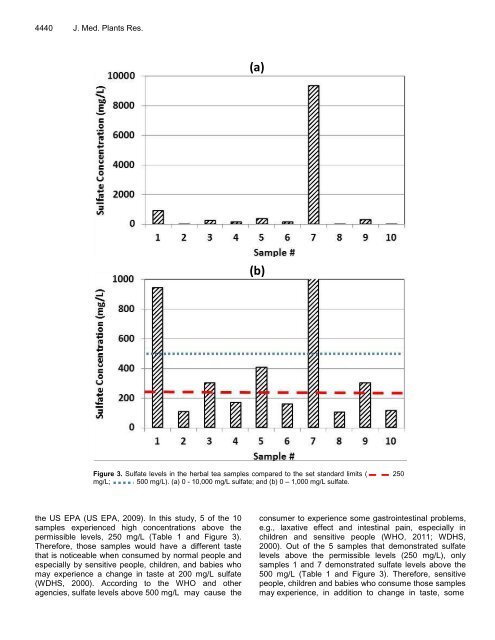4440 J. Med. Plants Res. Figure 3. Sulfate levels in the herbal tea samples compared to the set standard limits ( 250 mg/L; 500 mg/L). (a) 0 - 10,000 mg/L sulfate; and (b) 0 – 1,000 mg/L sulfate. the US EPA (US EPA, 2009). In this study, 5 of the 10 samples experienced high concentrations above the permissible levels, 250 mg/L (Table 1 and Figure 3). Therefore, those samples would have a different taste that is noticeable when consumed by normal people and especially by sensitive people, children, and babies who may experience a change in taste at 200 mg/L sulfate (WDHS, 2000). According to the WHO and other agencies, sulfate levels above 500 mg/L may cause the (a) (b) consumer to experience some gastrointestinal problems, e.g., laxative effect and intestinal pain, especially in children and sensitive people (WHO, 2011; WDHS, 2000). Out of the 5 samples that demonstrated sulfate levels above the permissible levels (250 mg/L), only samples 1 and 7 demonstrated sulfate levels above the 500 mg/L (Table 1 and Figure 3). Therefore, sensitive people, children and babies who consume those samples may experience, in addition to change in taste, some
Table 3. Herbal tea ingredients and intended medicinal use (Arrowsmith, 2009; Gaby and Lininger, 2006; Peter, 2004). Herbal tea major ingredient Intended medicinal use Abouleish and Abdo 4441 Anise Gas and indigestion problems Balm Calming nerves and flatulence problems Chamomile Colic, diarrhea, gastritis, heart burn, indigestion, and teething problems Fennel Colic, heart burn, and indigestion problems Peppermint Colic, gas, flatulence, indigestion, and stomachic problems Rose hip Diarrhea problem Thyme Colic, constipation, gas, flatulence, indigestion, spasms, and stomachic problems gastrointestinal problems. The sulfate contamination in the herbal tea samples is from the herbal products’ ingredients as the water used in this research for the preparation of the herbal tea samples contained no sulfate. Such high levels of chloride and sulfate in the herbal teas’ ingredients could have resulted from different sources such as from the plant itself due to environmental contamination during harvesting, and/or after harvesting (e.g. handling, cutting, dehydration processes, and equipment). Herbal tea label Not all the herbal tea brands reported the same information on the labels. Some of the brands reported energy content, concentration of carbohydrates, proteins, fats, and sodium and calcium on the labels. Results from this research and other research (Abouleish and Abdo, 2012) suggest that the labels of the herbal teas need to report information on the contaminants present, such as the levels of fluorides, chlorides, sulfates, nitrates and nitrites, since they may cause problems. In conclusion, this research demonstrated that the studied herbal tea brands are contaminated with chloride and sulfate anions, which could lead to a change in the taste of the herbal tea product. In addition, some samples showed sulfate levels that exceeded the permissible levels, therefore, suggesting that those samples could cause sensitive people, children and babies to experience gastrointestinal problems. The herbal tea samples tested in this research are used for treating different health conditions such as indigestion, gas, cramps, and diarrhea, as presented in Table 3 (Arrowsmith, 2009; Gaby and Lininger, 2006; Peter, 2004). The presence of sulfate in those herbal tea samples decreases the effectiveness of those herbal tea products as they may cause other problems, therefore, defying their intended purpose. As a result, contamination of such products should be taken into consideration when they are consumed voluntarily or when prescribed by a physician. Therefore, this research suggests that the herbal tea products must be tested for chemical contamination, as this reflects on the quality of the product as well as on the manufacturing process. In addition, herbal tea samples are used for medicinal purposes and, as a result, must fall under stringent regulations in terms of manufacturing and quality control. ACKNOWLEDGEMENT We would like to thank the American University of Sharjah for funding this research and providing the necessary equipment. REFERENCES Abouleish MY, Abdo N (2012). Assessment of nitrate and nitrite contamination in herbal tea products. J. Med. Plants Res. 6:3555- 3560. AHPA-ERB, American Herbal Products Association Foundation for Education and Research on Botanicals (2008). A field guide to herbal dietary supplements. Maryland, USA: AHPA-ERB Foundation. Accessed December 2011[Online] Available: www.ahpa.org Arrowsmith N (2009). Essential herbal wisdom: A complete exploration of 50 remarkable herbs. MN, USA: Llewellyn Publications, pp. 531- 538. Bakerink JA, Gospe Jr SM, Dimand RJ, Eldridge MW (1996). Multiple organ failure after ingestion of pennyroyal oil from herbal tea in two infants.Pediatrics 98:944-947. Chutia J, Sarma SP (2009). Relative contents of chloride and sulphate in drinking water samples in different localities of Dhakuakhana subdivision of Lakhimpur district of Assam. Int. J. Chem. Sci. 7:2087- 2095. D’Alessandro W, Bellomo S, Parello F, Brusca L, Longo M (2008). Survey on fluoride, bromide, and chloride contents in public drinking water supplies in Sicily (Italy). Environ. Monit. Assess 145:303-313. DNHW, Department of National Health and Welfare (1978). Guidelines of Canadian drinking water quality: Supporting documentation. Ottawa, Canada. EC, European Commission (1998). Council directive 98/83/EC of 3 November 1998, on the quality of water intended for human consumption. Off. J. Eur. Comm. L 330:32-54. Gaby AR, Lininger SW,Eds.(2006). The natural pharmacy: <strong>Complete</strong> A- Z reference to alternative treatments for common health conditions. Maryland, USA: Crown Publishing Group, pp. 3-764. Ize-Ludlow D, Ragone S, Bernstein J, Bruck I, Duchowny M, Pena B (2004). Chemical composition of Chinese star anise (Illicium verum) and neurotoxicity in infants. JAMA 291:562-563. Peter KV, Ed. (2004). Handbook of herbs and spices. Cambridge, GBR: Woodhead Publishing Limited, pp. 1-349. Rembialkowska E (2007). Quality of plant products from organic agriculture, J. Sci. Food Agric. 87:2757-2762. Saper RB, Kales SN, Paquin J, Burns MJ, Eisenberg DM, Davis RB, Phillips RS (2004).Heavy metal content of ayurvedic herbal medicine

















